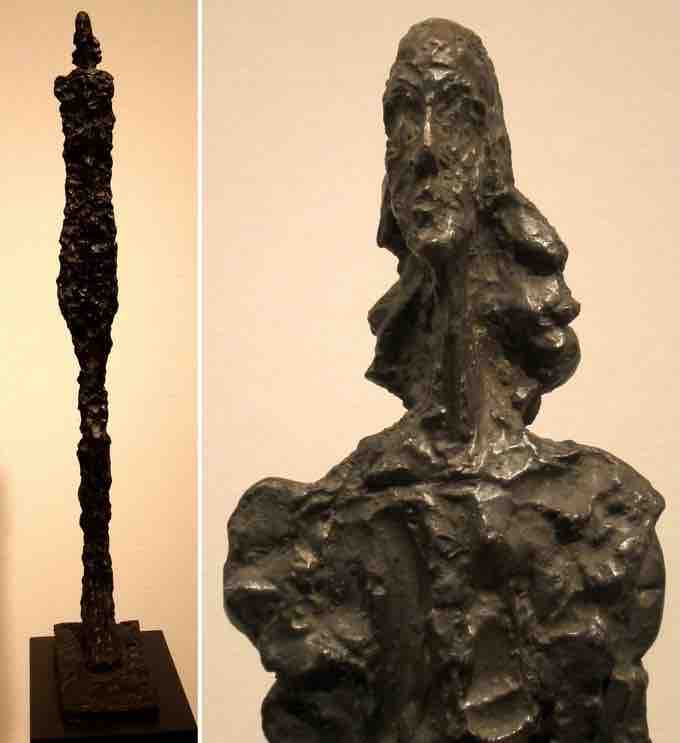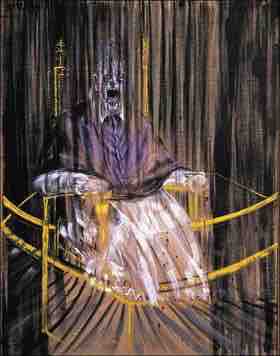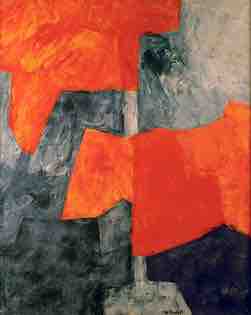Introduction
In the Postwar period, the center of modern artistic activity in the west shifted from Paris to New York. One of the biggest contributing factors to this shift was the advent of Abstract Expressionism, a decidedly American movement that is often cited as the first American avant-garde. Visionary figures like Jackson Pollock, Mark Rothko and Barnett Newman epitomized Abstract Expressionism in New York, but a similar concern for Expressionism was present in the work of many important European artists in the aftermath of WWII.
The Postwar Figure
While both American and European artists were influenced by the postwar rhetoric of anxiety, alienation and disillusionment, the American school was also heavily influenced by Surrealism, and moved increasingly toward reductive abstraction and away from representing biomorphic forms as a means for pursuing the self-expression of the unconscious. Unlike American Expressionism, which was more abstract, many European painters maintained the primacy of the figure in their work. More concerned with the philosophical and cultural movement of Existentialism, European artists grappled with the meaning of the figure and its isolated, individual experience of the world. Existentialist themes often framed the work of figurative artists such as Francis Bacon, Lucian Freud, and Alberto Giacometti. Bacon and Freud were British painters who often painted expressive portraits noted for their psychological penetration. Giacometti was a Swiss painter and sculptor mostly known for his sculptures of isolated, attenuated figures. These figures were thought to reflect the postwar view that life was increasingly void of meaning.

Alberto Giacometti, Woman of Venice VII, Alberto Giacometti, Woman of Venice VII, 1956, bronze. Art Gallery of New South Wales.
Giacometti's "Woman of Venice" presents the typical solitary figure often seen in his work which was heavily influenced by existentialist modes of thought.

Francis Bacon, Study after Velazquez's Portrait of Pope Innocent X, 1953, oil on canvas, 60 x 46 in. De Moines Art Center, De Moines, Iowa.
This painting by Bacon exemplifies a figurative portrayal of existential and individual angst that European Expressionists typically display in their work.
Tachisme/Art Informel
During this time period, there were also European artists who engaged more fully in abstraction, particularly those associated with the French painting movements Tachisme (from the French word tache, meaning stain) and Art Informel. Tachisme is often regarded as the closest European equivalent to American Abstract Expressionism, and can be characterized by spontaneous brushwork, drips and blobs of paint applied directly from a tube, and, occasionally, a scribbling reminiscent of calligraphy. Important Tachisme painters include Jean-Paul Riopelle, Jean Dubuffet, Pierre Soulages, Nicholas de Stael, Hans Hartung, Serge Poliakoff , Georges Mathieu and Jean Messagier. Art Informel, a movement closely related to Tachisme, rejected the geometric, hard-edge style of American abstraction in favor of a more intuitive form of expression. "Informel" referred to the lack of form itself and the absence of a premeditated structure.

Serge Poliakoff, Composition grise et rouge
Serge Poliakoff painted in the French tachisme style of Art Informel, an abstract movement which is often considered to be the European counterpart to Abstract Expressionism.